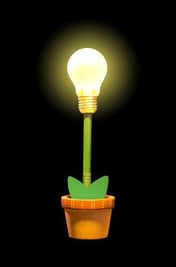LED Lighting Guide for Contractors

A clear understanding of how LED lighting works can open immense possibilities for contractors to be able to evaluate and compare performance of luminaires. It will also enable providers to propose the right luminaires for clients based on knowledge of light installations and how they are predicted to perform.
Benefits of LED Lighting
 LED or light-emitting diode has revolutionized light installations. This type of lighting requires less energy and loses less heat. The life of a LED bub is longer compared to the traditional ones. Life spans are quoted by companies from 50,000 to 100,00 hours or nearly 100 times longer than the traditional bulb.
LED or light-emitting diode has revolutionized light installations. This type of lighting requires less energy and loses less heat. The life of a LED bub is longer compared to the traditional ones. Life spans are quoted by companies from 50,000 to 100,00 hours or nearly 100 times longer than the traditional bulb.
In addition, it does not need a lot of maintenance and replacement making it cost-effective. To demonstrate, a typical LED lighting will produce over 100 lumens per watt (LPW). Lumen is the amount of light emitted from a source. A 100W incandescent bulb will produce the same luminosity but will use up more energy compared to LED bulbs.
Not only is LED cost-effective, it has outstanding color quality and excellent efficiency. Color rendering index (CRI) is the term used to define the ability of light or lamp to replicate the colors of an object on a scale of 1 to 100 where 100 is the equivalent of sunlight.
LED lighting is also smaller and compact, an easy and quick job for contractors.
What to Look for When Purchasing LED Lighting
The most important specification when buying LED is lumen output. This means that when proposing lights for certain living spaces, you will consider the amount of light it produces (brightness) and ensure it is adequate for your customers' requirements. For example, you will need brighter lights in working spaces such as the kitchen and dimmer lights in the bedroom to induce sleep.
 Then you will need to look at the LPW or lumens per watt. Put simply, this is the amount of lumens produced for every watt that is used. The higher the number, the better it is in order to match the CCT or the correlated temperature (measurement of coolness or warmth) measured in kelvins (K). It indicates whether a light is warm, neutral or cool white in appearance. Finally, you have to compare the CRI, with a higher rating a better choice, that is, greater than 80 is rated as good and greater than 90, very good.
Then you will need to look at the LPW or lumens per watt. Put simply, this is the amount of lumens produced for every watt that is used. The higher the number, the better it is in order to match the CCT or the correlated temperature (measurement of coolness or warmth) measured in kelvins (K). It indicates whether a light is warm, neutral or cool white in appearance. Finally, you have to compare the CRI, with a higher rating a better choice, that is, greater than 80 is rated as good and greater than 90, very good.
Other Features to Consider
Safety certifications vary across different regions in the world such as UL, ETL, CSA, NOM and CE. Products must be rated for moisture conditions and intended use/application such as dry, damp or wet. You might see two codes: ingress protection (IP) and insulation contact (IC). IP ratings consist of two numbers: first one indicates protections against solids including dust (0-6 where 0 means not protected and 6 well-protected). IC ratings indicate protections against liquids (0-8 where 0 means not protected and 8 means that it can be submerged in liquids).
Overall, contractors have a large number of reasons for using LED light bulbs as opposed to rival bulb types. As mentioned above these range from flexibility of design and function, to lower energy costs and longevity. The LED bulb's market share is growing just as its purchase price decreases. This is giving contractors the perfect opportunity to create new, stunning and innovative designs, features, and displays that has not been possible until now. Using LEDs will give you the design edge you are looking for to stand out from the crowd.
Guest Blogger: Leigh Marcos worked in home design and lighting before becoming a mother of two and a freelance writer. A keen photographer, she enjoys taking her dogs for long walks through the countryside in the hope of getting that perfect shot.








